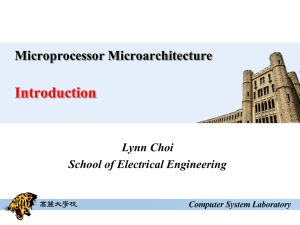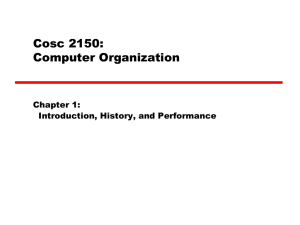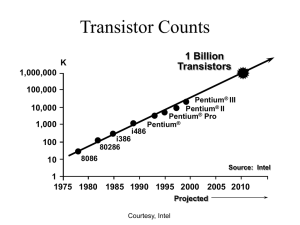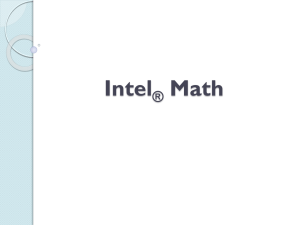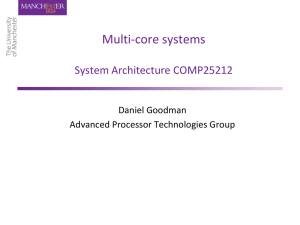Medical Ultrasound
advertisement
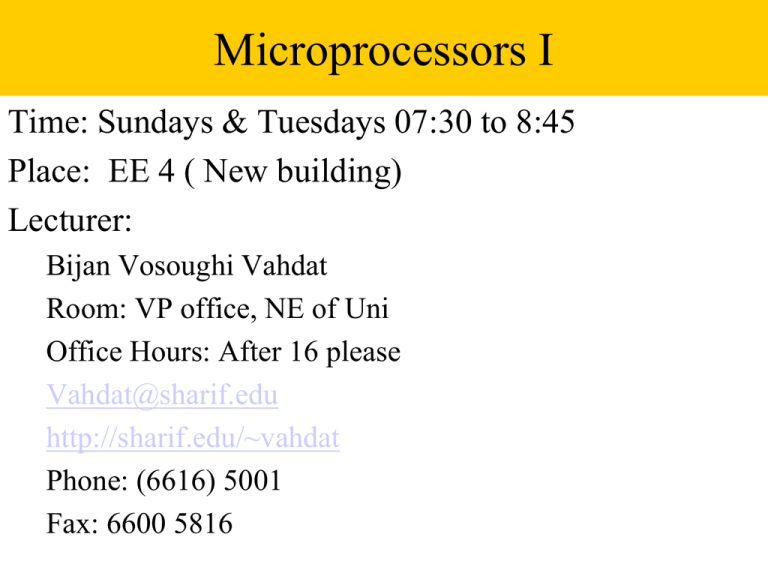
Microprocessors I Time: Sundays & Tuesdays 07:30 to 8:45 Place: EE 4 ( New building) Lecturer: Bijan Vosoughi Vahdat Room: VP office, NE of Uni Office Hours: After 16 please Vahdat@sharif.edu http://sharif.edu/~vahdat Phone: (6616) 5001 Fax: 6600 5816 Grading Policy • Homework: – Subject: UPI2010:HWX:IDxxxxxxxx • Quiz: • Mid-term Exam • Final Exam: • Final Project: • Presenting New Materials on Microprocessors • Paper Discussion 15 10 25 25 25 +5 +5 Resources • Microprocessors and Interfacing Douglos V. Hall • 5 Volumes from Intel - Intel® 64 and IA-32 Architectures - Software Developer’s Manual – – – – 1: Basic Architecture 2A: Instruction Set A-M 2B: Instruction Set N-Z 3A, 3B: System Programming Guides Reference Book Text: Table of Contents 1. 2. 3. 4. 5. 6. 7. 8. 9. 10. 11. 12. 13. 14. 15. 16. Computer Number Systems, Codes, and Digital Devices Computers, Microcomputers, and Microprocessors —An Introduction 8086 Family Assembly Language Programming—Introduction Implementing Standard Program Structures in 8086 Assembly Language Strings, Procedures, and Macros 8086 Instruction Descriptions and Assembler Directives 8086 System Connections Timing, and Troubleshooting 8086 Interrupts and Interrupt Applications Digital Interfacing (PPT ) Analog Interfacing and Industrial Control (D/A – A/D – DSP) Dma, Drams, Cache Memories, Coprocessors, and Eda Tools C, a High-level Language for System Programming Microcomputer System Peripherals (Keyboard –Display –HDD –Printer) Data Communication and Networks ( Async – Sync –LAN - GPIB) The 80286, 80386 and 80486 Microprocessors An Introduction to the Pentium Processors (New Edition) Covered by 5 Volums • • • • • • • • • • • • • Pentium® processors P6 family processors Pentium® 4 processors Pentium® M processors Intel® Xeon® processors Pentium® D processors Extreme Editions 64-bit Xeon® processors CoreTM Duo processor CoreTM Solo processor Dual-Core Xeon® LV Xeon® processor 3000, 3200 Xeon® processor 5000 • Intel® CoreTM 2 – – – – – – – • • • • • • • Duo processor Quad Q6000 series Extreme X7000 and X6800 Extreme QX6000 Extreme QX9000 - X9000 Quad Q9000 series Duo E8000, T9000 Intel® Xeon® 5100, 5300 series Intel® Xeon® processor 7100 Intel® Pentium® Dual-Core Xeon® processor 7200, 7300 Xeon® 5200, 5400, 7400 AtomTM processor family Intel® CoreTM i7 processor History: 1/4 • • • • • • • • • 1971 4004 4bit, 4K, 50KIPS 1972 8008 8bit, 16K 1974 4040 Like 4004, Higher speed 1974 8080 Like 8008, 64K, TTL 1977 8085 Updated 8080, 246 Instr. 1978 8086 Architecture from 8080 1979 8088 1980 8087 Floating-point coprocessor 1981 80286 extended the 8086 (16M) – 1st Fully Compatible with its predecessor History: 2/4 • • • • • • • • • • 1985 80386 32 bits data 1989 80486 Containing Coprocessor 1992 Pentium Superscalar Architechture 1995 Pro : 4 Instructions added to 386 1997 PentiumII with MMX Technology 1998 Pentium II Xeon 1999 Celeron PPGA 1999 Pentium III 2000 – 2006 Pentium® 4 Processor Family 2001- 2007 Xeon® Processor History: 3/4 • 2003-Current Pentium® M Processor • 2005-2007 Pentium® Processor Extreme Edition • 2006-2007 The Intel® Core™ Duo and Intel® Core™ Solo Processors • 2006-Current The Intel® Xeon® Processor 5100, 5300 Series and Intel® Core™2 Processor Family History: 4/4 • 2007-Current The Intel® Xeon® Processor 5200, 5400, 7400 Series and Intel® Core™2 Processor Family • 2008-Current The Intel® Atom™ Processor Family • 2008-Current The Intel® Core™i7 Processor Family Where to go Intel 4004 • • • • • 4 bit microprocessor 4KB of memory 45 instructions 50 KIPS(Kilo-instructions per second) Main problems: – Speed – word width – memory size 8086 / 8088 • • • • 16-bit microprocessor 2.5 MIPS 1MB of memory A small 4- or 6-byte instruction cache or queue • Over 20,000 variations of instructions • The popularity of the Intel family ensured in 1981 by IBM 80386 • • • • • • 275,000 transistors Intel’s first practical 32-bit microprocessor 32-bit data bus and memory address 4GB of memory Memory management unit Multitasking Pentium • P5 architecture / 80586 • Introductory version: 60MHz and 66MHz, 110MIPS / 100MHz, 150MIPS • 16KB of cache size (8KB IC, 8KB DC) • 4GB of memory system, 64-bit data bus • Executes up to two instructions at a time (If they don’t conflict!) P5 Architecture Pentium Pro Processor • P6 architecture • 5.5M Transistors, 3 integer units, floating-point unit • Basic clock frequency: 150 MHz and 166MHz • 16K L1 Cache(8K for data and 8K for instructions) + 256K L2 Cache • Execute up to three instructions at a time (It doesn’t matter even if they conflict!) P6 Architecture Three-way Superscalar, pipelined architecture P6 Architecture Pentium II Processor • • • • P6 architecture 7.5M Transistors Initially ran at 233MHz and 266MHz 32KB L1 Cache + 512KB L2 Cache (External → 50% of processor speed) • Arranging the amount of L2 Cache → Celeron(1999) or Xeon(1998) Pentium III Processor • • • • P6 architecture 9.5 Million transistors 450 and 500 MHz SSE(Streaming SIMD Extensions) instructions • Improved L1 cache controller • Low-end Celeron / High-end Xeon Pentium 4 Processor • NetBurst architecture • Deep instruction pipeline, SSE2, 64-Bit floating point computation • 42 Million transistors, 1.4 GHz and 1.5 GHz • Hyper Threading Pentium M Processor • M for Mobile: Laptop • Execution core of the Pentium III + Pentium 4 compatible bus interface • Improved instruction decoding/issuing front end + improved branch prediction + SSE2 support • a much larger cache • Low average power consumption, Lower heat output than desktop The Intel® Core™i7 Processor • support Intel 64 architecture • Based on Intel micro-architecture (Nehalem) using 45 nm process technology. • Intel® Turbo Boost Technology converts thermal headroom into higher performance. • Intel® HyperThreading Technology in conjunction with Quadcore to provide four cores and eight threads. • Dedicated power control unit to reduce active and idle power consumption. The Intel® Core™i7 Processor • Integrated memory controller on the processor supporting three channel of DDR3 memory. • 8 MB inclusive Intel® Smart Cache. • Intel® QuickPath interconnect (QPI) providing point-to-point link to chipset. • Support for SSE4.2 and SSE4.1 instruction sets. • Second generation Intel Virtualization Technology.
